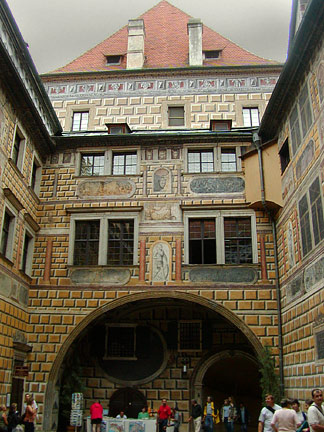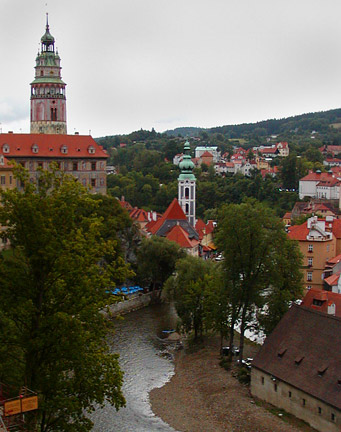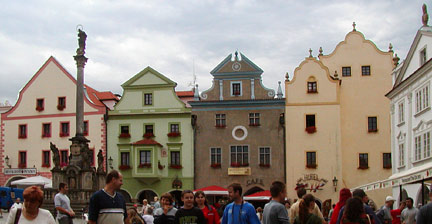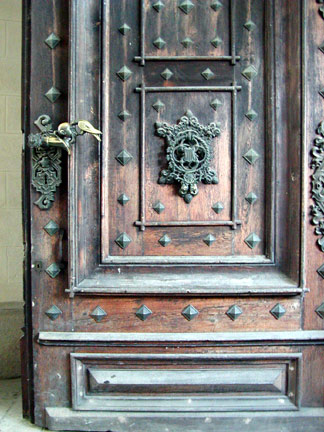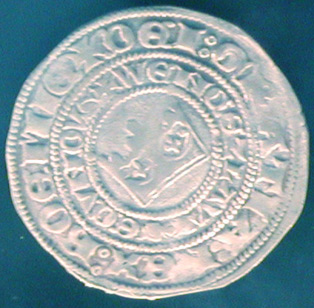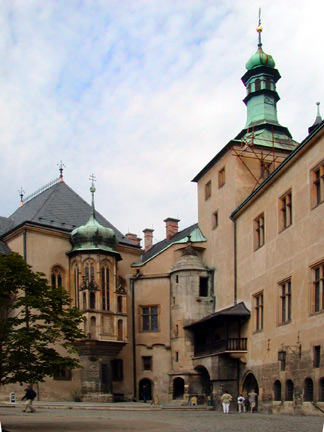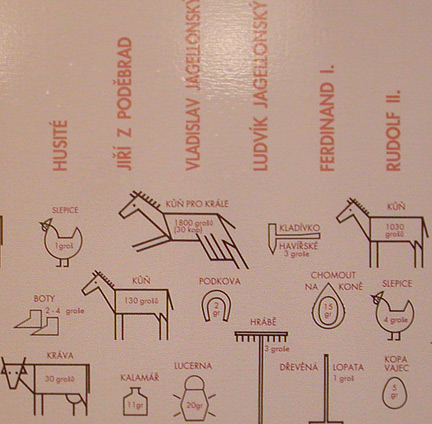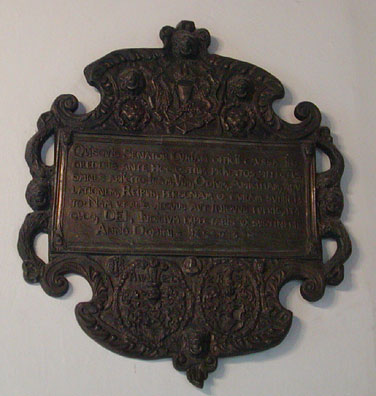|
Bohemia is the western portion of the Czech Republic where we visited in July 2003. In the center of Bohemia is Prague, the capital city of the Czech Republic. Please visit our Prague page for more details on that beautiful city.
Our first stop in Bohemia was in Český Krumlov (below right) in the very south of the country. This town is a small medieval town built in the “S” curve of the Vltava River. On the hill above sits the 13th century castle rebuilt into a huge Renaissance chateau by 16th century Italian architects, looking over the river and the town below.
The chateau is a complex of buildings all ornately decorated. The lower part with the round tower (looking something like a tall, narrow wedding cake) is the oldest part of the chateau. The outer walls are all elaborately painted to look like stonework, pillars and statues, as can be seen in the inner courtyard, above left. The chateau is open to visitors for a couple of different tours, but just wandering through the grounds is a great way to explore. Plus, you get great views of the town below. Above the palace are the Italian-style gardens for peaceful strolls. As you enter the chateau you cross a bridge over pit. In the pit lives a bear which seems to be well taken care of, but which we felt sorry for because of the restricted area.
|
The town is full of old restored homes and has a charming central square, complete with its plague column from 1716. The gothic St. Vitus church punctuates the skyline just a block off the main square. While there were many tourists there, the town does not have a hectic touristy feel to it. The square with the plague column is shown in the photo at right.
One of the main activities in the town is rafting or canoeing the river around the town. The river is quick-flowing and smooth, except for the 3 weirs. Quite unknowingly, we opted for a lunch at a riverside terrace which just happened to be located at one of these weirs. Needless to say, this was one of our most entertaining lunches, watching the boaters float down.
|
|
|
|

|
Off to the side of the weir there is a chute where the boats can go down. However, the bottom of the chute is almost impossible to successfully run with a canoe. The rafts managed it well, but only one canoe with 2 young lads in it were totally successful. at left is a shot of one of the many unsuccessful canoes, just as they were going under. The angle of decent caused the nose to dip under the water as the canoe hit the lower water level. Once water entered the canoe, it was weighted down and either tipped or continued to fill. Luckily the water was rather shallow so it was easy enough to get out and right the canoe. But everyone at the restaurant as well as those that lined the riverbank certainly enjoyed the show and cheered the participants on.
|
|
|
We then traveled north about 35 km to the small town of Hluboká nad Vltavou. Here we found what had been described to us as the “most beautiful Czech castle” (right). The first time we saw it (traveling by after Verna’s bike broke down), it certainly did look majestic sitting up on the hill, gleaming in the setting sun. But we we came back to view it more closely, the day was gray with rain and somehow it wasn’t the same. Nevertheless, we walked up the hill to the castle and found it to be quite beautiful, at least on the outside. We tried to get in on a tour, but our timing was lousy and they only had tours in Czech for the rest of the day. Somehow, we thought we might miss some of the adventure by not understanding the language.
|
|
|
The original castle was built in the 13th century, then rebuilt between 1841 and 1871 in the style of Windsor Castle. Below left is the greenhouse adorned with wrought iron and part of the extensive gardens. As we were standing in line for the tickets, we were standing in the doorway to the castle we had a great view of one of the front doors shown below, right. The door handle is a man’s head with a bird that appears to be pecking at this brain. We are sure there is a story behind this, but it will have to wait until we take the tour in English! The impressive thing about this door is that what is shown is only the lower third of it. The handle and door knocker were at about Verna’s eye level. The doors were absolutely massive and we thought they might look nice in our next house (ha!).
The next stop was in north Bohemia, just 66 km east of Prague in a small town called Kutna Hora. In the 14th century, Kutna Hora was the second-largest town in Bohemia after Prague. The reason for this was the silver mined below the city and minted into silver groschen, the Czech currency of that time. In the 16th century, the boom ended and mining ceased in 1726, so the medieval towns cape remains about the same as it was then. The photo below is one side of the main square with its colorfully restored houses.
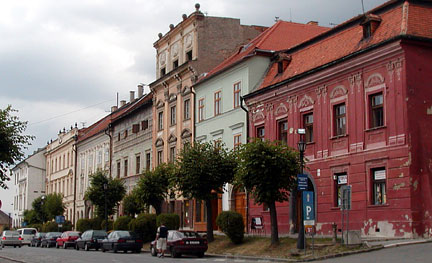 |
|
One of the jewels of Kutna Hora is the Italian Court which served as the Royal Mint. The photo at right shows one corner of the inner courtyard. Beginning in the 1300s this was a mint for coins made of the silver mined below the city, later to be used for city hall functions, then during the Napoleonic wars served as a hospital. Today it serves as a museum to tell the stories of its history. The coin pictured above was the first coin minted here from 1283-1305. It is called a groschen and was made form 15 parts silver and 1 part copper.
|
|
|
|
A chart in the hall shows what the price of goods were in those times, a portion of which is pictured at left. As you can see, they suffered from inflation then as now - a hen was 1 grochen under King Huisite, then 4 groschen later under Rudolf II. This was partly due to the fact that they kept increasing the amount of copper in relation to silver, thus devaluing the money.
|
|
|
|
In the 1500s when the building was used for council meetings, a creed was instilled for behavior during the meetings in the Royal Audience Hall. This creed is still used today and a copy of this original plaque is displayed in the United Nations building (below).
Translated, the plaque says:
“Every member of the council, having to enter this door to accomplish your official duty, put off all your passions: Hate, Hostility, Force, Friendship, Hypocrisy; all your troubles submit to your community. The same justice you would do to others, the same reward you have to attend and to bear by our Lord’s judgment. A. D. 1595.”
Still true today as it was then.
|
|
|
|
Also in the Italian Court is a small chapel, built in the 1400s then ornately decorated in an Art Nouveau style in the early 1900s.
At left is a piece of the beautifully made stained glass.The photo at right shows a section of the paintings depicting St. Barbara (saint of the mines) kneeling with the lamp in the lower right. Behind her is the silhouetted skyline of Kutna Hora
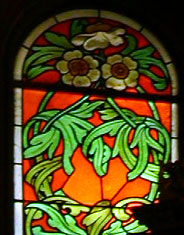
|
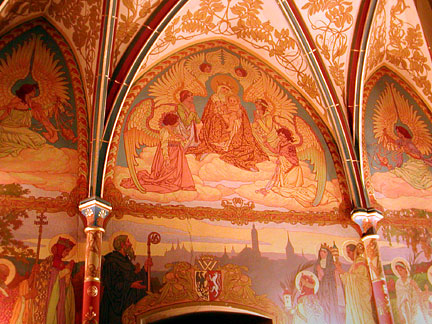
|
|
|

